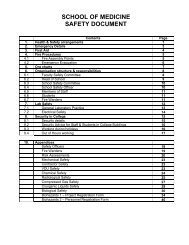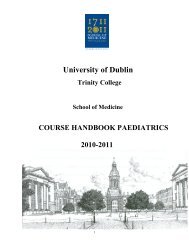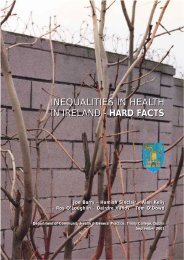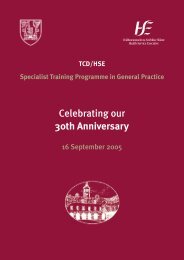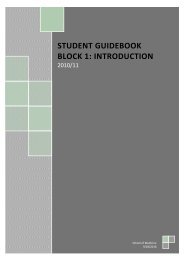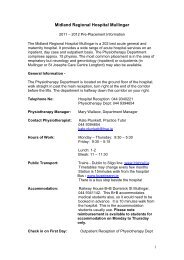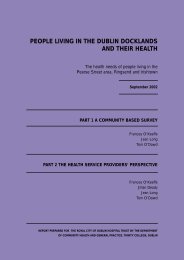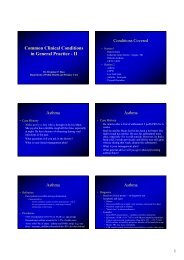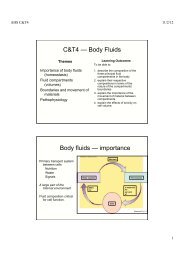PG1006 Lecture 7 The Extracellular Matrix
PG1006 Lecture 7 The Extracellular Matrix
PG1006 Lecture 7 The Extracellular Matrix
- No tags were found...
Create successful ePaper yourself
Turn your PDF publications into a flip-book with our unique Google optimized e-Paper software.
<strong>PG1006</strong><strong>Lecture</strong> 7<strong>The</strong> <strong>Extracellular</strong> <strong>Matrix</strong>Dr Neil Docherty
My Teaching Objectives• To explain the nature, structure and function ofglycosaminoglycans and proteoglycans• To describe the synthesis of collagen fibres• To explain the structure and function of elastin and fibronectin• To illustrate the assembly of the basal lamina as a specilaisedsupport and compartmentalisation connective tissue• To outline the connective tissue classification scheme
What are Fibroblasts Making?Principal E.C.M. ComponentsElasticproteinsCore proteinsProteoglycans(PGs)E.C.M.Glycosaminoglycans(GAG’s)Cell-E.C.Mintegratingproteinsfibrous proteinsNetwork formingproteins
Physical Properties of the E.C.M.• Tensile Strength(fibrous proteins-fibre forming collagens)• Resistance to Compression(hydrated gel formation-GAGs and PGs• Elastic recoil(elastin protein polymerisation)Variability in relativecontribution ofcomponents reflectsneeds of the localmicroenvironmentand function oftissuee.g. Blood vesselsversus bone
<strong>The</strong> E.C.M. and CellsE.C.M.ShapeSurvivalSpecialisedfunctionProliferationMaturation Migration
Glycosaminoglycans (GAGs)• Unbranched linear polysaccharides• Disaccharide repeat structure• Negatively charged COO and SO 3-Groups (attract cations, maintainHydration in E.C.M)Main groups classified by;1) Sugar types2) Glycosidic linkages3) Number of sulphated groups4) Location of sulphated groupsDermatan sulphateMajor Types1) Hyaluronan2) Heparin3) Heparan Sulphate4) Chondroitin sulphate5) Dermatan sulphate6) Keratan sulphate
Hyaluronan25,000 non-sulfated disaccharide unitsActs as a long fibre for the assembly of multi-molecularComplexes with PGs (via linker proteins)
Proteoglycans (PG)• GAG chains linked covalently to coreproteins at serine residues.
PG Size is VariableVaries with;Size of the core proteinHence number of serine sites for GAG attachmentLength of GAG attachments
PG FunctionsAbundance and capacity for structuraldiversity leads to diverse function• Via the GAG chains;-Gel formation-Gel pore size and charge selctivity-Activation of growth factors-Stabilisation and formation of gradients ofchemotactic molecules• Via the core protein-Sequestration of growth factors-Coordination of PGs with fibrous proteins-Integration into membrane (PG receptors)
Fibrous Proteins-<strong>The</strong> Collagens• Collagens are the most abundant (25%) proteins in thebody-Can form either fibres or networks-Above lead to tensile strength and/ or compartmentalisation-Triple helical polymers of indidual “alpha chains”-Helical structure reliant on Gly-X-Y amino acid repeats
Gly-X-Y Repeat and PolymerisationGlycine (the smallest amino acid)packs the centre of thehelixAllows projection of X Y repeatsWhich are usually eitherProline-Lysine or Lysine-ProlineSubsequenthydroxylationAlpha chainAlpha chain polymer
Collagen Synthesis and Fibril Formation
Lysl oxidase enzymecatalyses aldol linkagebetween lysineresidues.Collagen Fibril Formation
Type IX Collagen Organises <strong>The</strong> Fibrils
ElastinOXIDATIVEDEAMINATIONElastin is polymer of 70kDa tropoelastinPredominantly GLY, VAL, ALA, PROTROPOELASTIN ELASTINSolubleinsolubleLysl oxidaseClass QuestionCan we think of any structures in the bodyin which elastin would help structure tomatch function?
FibronectinMajor Linker of Cells to E.C.M. via RGD binding sites
Network Forming Collagen IVDirectly binds integrins
Laminin• Trimer of alpha, beta and gamma subunits• Also directly bind integrins on cell surface• Engage in homotypic and heterotypic protein-proteininteractions (What does this mean??????)
Network ArraysCollagen IV and Laminin can form extensive arrays that arecross-linked by Perlecan (heparan sulphate PG) andNidogen (a.k.a. entactin)
<strong>The</strong> Basal Lamina-Compartmentalisation-Barrier function(Size and charge selective)-Collagen IV-Laminin,-Entactin,-Nidogen
Connective Tissue ClassificationEMBRYONIC-mesenchymal-mucosalCONNECTIVETISSUEADULTLOOSE-most organssurroundingvessels etc.-Inc. basallaminaDENSE-most organsunderlyingloose CT-Fibrillar-Can be regular(e.g tendon) orIrregular (e.gdermis)SPECIALISED-Reticular-Adipose-Cartilage-Bone-Blood?
Your Learning from TodayShould focus on being able to1) Explain the nature, structure and function ofglycosaminoglycans and proteoglycans2) Describe the synthesis of collagen fibres3) Explain the structure and function of elastin and fibronectin4) Describe the components and assembly of the basal lamina5) Outline the connective tissue classification scheme





